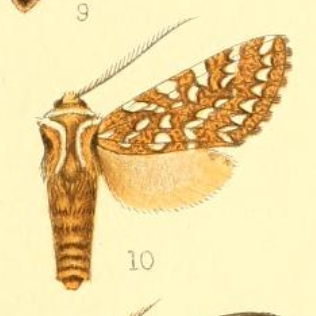
Bindahara phocides, the plane, is a small butterfly found Indomalayan and Australasian realms that belongs to the lycaenids or blues family.

Acrapex brunnea is a species of moth of the family Noctuidae first described by George Hampson in 1910. It is found in Africa, including Angola, Kenya and South Africa.

Acrapex spoliata is a species of moth of the family Noctuidae first described by Francis Walker in 1863. It is found in Africa, including Sierra Leone and South Africa.

Lophocampa affinis is a moth of the family Erebidae. It was described by Walter Rothschild in 1909. It is found in Mexico.

Lophocampa andensis is a moth in the family Erebidae. It was described by Schaus in 1896. It is found in Colombia.
Haritalodes polycymalis is a moth in the family Crambidae. It was described by George Hampson in 1912. It is found in the Democratic Republic of the Congo, Guinea, Ivory Coast, Kenya, Madagascar, Malawi, Mozambique, Sierra Leone, South Africa (KwaZulu-Natal), Tanzania and Uganda.
Pilocrocis pachyceralis is a moth in the family Crambidae. It was described by George Hampson in 1917. It is found in Papua New Guinea.
Sameodes furvipicta is a moth in the family Crambidae. It is found in Papua New Guinea.
Syllepte melanomma is a moth in the family Crambidae. It was described by George Hampson in 1912. It is found in Nigeria.
Syllepte tetrathyralis is a moth in the family Crambidae. It was described by George Hampson in 1912. It is found in New Guinea.
Syllepte rogationis is a moth in the family Crambidae. It was described by George Hampson in 1918. It is found in Mozambique.
Udea ferrealis is a moth in the family Crambidae. It was described by George Hampson in 1900. It is found in Amur in the Russian Far East.
Ulopeza sterictodes is a moth in the family Crambidae. It was described by George Hampson in 1912. It is found in Papua New Guinea.
Ambia fulvicolor is a moth in the family Crambidae. It was described by George Hampson in 1917 and it is found in New Guinea.
Semioptila latifulva is a moth in the Himantopteridae family. It was described by George Hampson in 1920. It is found in Tanzania.
Semioptila trogoloba is a moth in the Himantopteridae family. It was described by George Hampson in 1920. It is found in Malawi and Mozambique.
Podalia albescens is a moth of the family Megalopygidae. It was described by William Schaus in 1900. It is found in Brazil.
Podalia fuscescens is a moth of the family Megalopygidae. It was described by Francis Walker in 1856. It is found in Brazil.
Podalia lanocrispa is a moth of the family Megalopygidae. It was described by E. Dukinfield Jones in 1912. It is found in Brazil.

Podalia orsilochus is a moth of the Megalopygidae family. It was described by Pieter Cramer in 1775. It is found in Mexico, Costa Rica, Brazil, Guyana and Venezuela.



